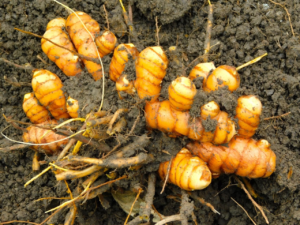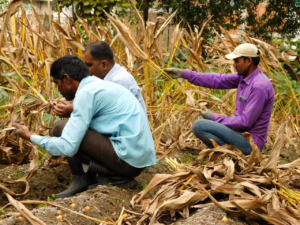 Welcome to the second in our series about the plants and herbs that can be found in Sambhavna’s stunning community gardens. The plant known in Hindi as haldi, botanical name curcuma longa of the zingiberaceae family, has a long and storied history in Ayurvedic medicine, in which it is also known as haridra. It is distinctive for its beautiful flowers, as well as for the golden-yellow colour of its rhizomes and the powder created from grinding them when dried. In English we know it as turmeric.
Welcome to the second in our series about the plants and herbs that can be found in Sambhavna’s stunning community gardens. The plant known in Hindi as haldi, botanical name curcuma longa of the zingiberaceae family, has a long and storied history in Ayurvedic medicine, in which it is also known as haridra. It is distinctive for its beautiful flowers, as well as for the golden-yellow colour of its rhizomes and the powder created from grinding them when dried. In English we know it as turmeric.
There are more than forty varieties of haldi on the Indian subcontinent alone, and it has an important history in Indian culture. Best known for its culinary properties and its use in traditional Indian cooking, turmeric was also used as a dye for fabrics. It is used in the traditional wedding ceremony known in Bengal as gaye holud (‘yellow on the body’), as well as other festivals and ceremonies across India. It is valued in Ayurvedic medicine for its many and diverse medicinal properties.
In traditional Ayurvedic medicine, haldi is used to treat Kapha disorders and mitigate toxins (ama). In modern medicinal terms, it is beneficial for the digestive system and is also a blood purifier. It has anti-bacterial, anti-fungal, anti-inflammatory, anti-carcinogenic, anti-allergic and body cleansing effects. It can also help to reduce blood sugar levels, bolster the immune system and improve digestion. Haldi is used in the preparation of three Ayurvedic medicinal formulations at the Sambhavna clinic:
1. Nishamalaki Vati: haldi combined with amalaki (known as Indian gooseberries, botanical name emblica officinalis). It is used for the treatment of diabetes mellitus, nephropathy and infections.
2. Haridra Khanda: used for the treatment of skin allergies including urticaria, eczema, blisters, pimples, fungal infections, allergic rhinitis and allergic bronchitis.
3. Haldi Churna: used in the treatment of diabetes mellitus, skin conditions, respiratory disorders, and joint disorders. It can be administered for both external and internal use. Haldi Churna is also used for taila murchana (a special pharmaceutical processing of oil to improve the colour, aroma, qualities, and digestibility and of the preparation).
 The many and diverse benefits of haldi make it particularly important to the work taking place at Sambhavna. Respiratory disorders and joint conditions are the two most common afflictions among survivors of gas exposure, while skin conditions and infections are the most common effects of exposure to contaminated water. The fact that haldi can be used to treat symptoms of all three, alongside modern medicines, make it an invaluable resource. Turmeric leaves are also picked fresh at the centre and dispensed to patients, along with instructions from staff for preparing tinctures to be consumed at home. These are most commonly prescribed for joint conditions, neuromuscular disorders, skin conditions, the treatment of wounds, and boosting the immune system.
The many and diverse benefits of haldi make it particularly important to the work taking place at Sambhavna. Respiratory disorders and joint conditions are the two most common afflictions among survivors of gas exposure, while skin conditions and infections are the most common effects of exposure to contaminated water. The fact that haldi can be used to treat symptoms of all three, alongside modern medicines, make it an invaluable resource. Turmeric leaves are also picked fresh at the centre and dispensed to patients, along with instructions from staff for preparing tinctures to be consumed at home. These are most commonly prescribed for joint conditions, neuromuscular disorders, skin conditions, the treatment of wounds, and boosting the immune system.
Again our thanks go to Sambhavna staff Vishwamohan, pharmacist, and Dr. Rupa, expert in Ayurvedic medicine, for sharing this information with us. Thanks also to our trustee Sathyu Sarangi for the beautiful photograph of the turmeric roots.


